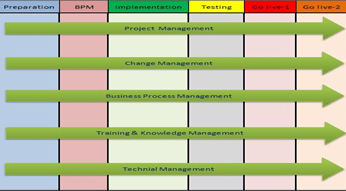Executives at contracting, engineering, equipment suppliers and professional service companies serving the asset-intensive oil and gas industry know that this is a challenging time to be in the industry. Customer organizations are more demanding than ever, and are asking their vendors to take on more risk, compete more aggressively on price and toe the line on quality.
Information technology certainly has a role to play in meeting these challenges, particularly since many companies serving the industry are still running their businesses on older enterprise applications not really suited for the information intensive nature of the industry. Enterprise applications designed to meet these needs are relatively new to the market, and ought to be considered carefully by industry executives charged with succeeding in the market today.
In this whitepaper, we will discuss the market trends affecting vendors to the oil and gas industry, how these trends are affecting operations and specific ways that enterprise technology can automate the best practices that will ensure success.
THE PRICE OF OIL
Whereas vendors in the oil and gas industry are affected by the same economic mega trends as everybody else, they are more directly affected by wild fluctuations in the price of oil than most other industries. Since the financial crisis in 2008, where we saw a steep drop in oil prices, we have seen a steady growth in the oil price and in the past two years, price stabilization at pre-recession levels. In addition, over the past few years we have seen annual double digit growth in offshore investments and in oil services. This large investment growth has led to intense competition for talent and resources, similar to what happened in the years prior to the financial crisis. In combination with increased global competition, this has caused cost levels to increase significantly, with the ensuing strong pressure on margins. As a result, wages and the other costs associated with oil exploration, extraction and processing have never been higher. This dynamic has created the need for oil companies to increase capacity while placing downward pressure on what can be spent to build new production assets or expand or extend the lifecycle of existing assets. Because of the stresses this combination has placed on the industry, many of the project owners in the industry have found that the vendors are more frequently not meeting their quality expectations.
Deadlines are missed, cost over- runs have become more frequent, and specifications are not met or are not communicated adequately between the different disciplines involved in these asset-intensive projects. Even though the blame for these problems probably lies jointly with the operator and the contractor, the oil company/operator is the customer, and they are demanding more accountability and greater control of their contractors and vendors.
This demand for accountability is one reason project owners/operators are moving over to an engineer, procure, construct (EPC) business model. With separate engineering, fabrication and construction, there is a lot of room for finger-pointing and blame-throwing when projects go wrong. To ensure that EPC contractors and other vendors have the capabilities necessary to meet budgets and timelines, operators are paying more attention to the IT infrastructure their suppliers are using. Technology is seen as the key to vendors’ ability to collaborate better internally, as well as with customers and sub-contractors. And this technology- enabled collaboration is the way to ensure that an EPC contractor, equipment vendor or other partner can plan, communicate and execute effectively enough to meet project deliverables.
ROLE OF TECHNOLOGY
Suppliers to this industry—equipment fabricators, maintenance and operations service companies and EPC contractors or those on their way to becoming EPC contractors —have slightly different technology needs. But they have one thing in common. They are being asked to do more with less, are being asked to take on more risk and need to collaborate more effectively internally and with trading partners and customers.
Moreover, as industry needs and the type of project available change, suppliers need to prepare for these new projects—which might have more to do with extending the life of existing assets than building new ones. Economic pressures may also drive many industry vendors toward new revenue streams, including aftermarket service and warranty work.
All of these changes place new demands on an IT infrastructure. In order to succeed in the industry now, oil and gas industry suppliers need enterprise applications that:
- Harmonize the working processes across disciplines, including engineering, fabrication, on-site construction, aftermarket service management and project management.
- Standardize processes to better secure quality, including work performed internally as well as work performed by outside contractors and subcontractors.
- Provide a complete overview of project risk, along with tools to manage risk pro- actively and in real time.
Given the multi-disciplined nature of EPC contractors and their need to manage often large and far-flung teams of contractors and subcontractors in a deadline- sensitive environment, their needs are perhaps the most extreme. But as more and more engineering, fabrication and contracting outfits are pressed into EPC contracts, they ought to consider the full EPC scope when selecting an enterprise application to ensure that all of these areas are supported.
Following is a breakdown of the specific needs of the various oil and gas industry suppliers, starting with the EPC contractors whose needs are, perhaps, the most complex.
EPC contractors need to pay attention to four essential elements:
- Project-driven materials management. Instead of letting a product structure and traditional manufacturing resources (MRP) planning system drive functions like demand, fabrication and testing, an EPC contractor needs to ensure that its enterprise application provides robust project resources planning tools. This allows it to better schedule tasks in parallel rather than in sequence. In an EPC environment, for instance, fabrication starts long before drawings and product structures are completed.
- Multidiscipline engineering register. Integration between engineering and purchasing/fabrication and other disciplines is beneficial for any industry, but is absolutely essential for an EPC contractor. Engineering functionality and a centralized engineering register deliver what is in essence a combined ERP and PLM solution. For companies that are involved in both engineering/ design and purchasing/material management—and maybe even fabrication/ installation—this central repository for engineering data that is shared throughout the enterprise allows for efficient and error-free handover of data between functions. It facilitates handover from engineering to purchasing, between fabrication and installation and maybe even, in the case of last- minute changes to the design, between engineering and installation. This level of integration delivers detailed tracking of those difficult and unexpected project changes. These changes are often difficult to manage because when there are design changes, it is not the part numbers that change, but rather the attributes of those part numbers, the documents attached to the part number and the tagged information. These details are lost if communication from engineering consists of a simple list of part numbers released to a fabrication department, hindering the ability to handle changes and increasing project risk.
- Re-contracting and Subcontracting. Traditional purchase orders are fine for acquiring materials and receiving them into inventory. But are they as good for specifying the amount and qualities of concrete to be put into place or outlining the scope of services for a subsea cabling contract? Contracts and subcontracts are not items received into inventory, but rather, represent complex agreements that involve careful development of the scope of services and then require careful performance management culminating in the application for payment process. Technology designed to handle the typical customer order—as is found in a traditional ERP application—will not adequately deal with the complexities of the subcontract, once again exposing an EPC contractor to risk due to the inability to proactively manage contractors and subs.
- Forecasting and project accounting. This enables project controllers to look at project data and make future projections of project performance rather than just seeing—after the fact—how they wound up over budget, behind schedule or off of the specification. This allows better project forecasting than many generic MRP-driven enterprise tools that are the equivalent of reading a newspaper—you can see what happened, but only when it is much too late to do anything about it, and it is impossible to look into the future. This real-time view of the project, which provides visibility into how project milestones are on-track or off-track and the implications for the project going forward, also enables cut-offs, reporting and forecasting independent of traditional transaction periods. It presents automated features for fetching cost data that need to be reported into the general ledger each period. It will also allow for automation of routines for revenue recognition, an important task to ensure timely payment by the customer.
 Service companies working in the oil and gas industry are a diverse lot. Companies that undertake project-driven services will need to ensure that their enterprise environment addresses the critical process of mobilization—ensuring that you have people and equipment available to do your job at the right place and at the right time. An enterprise application will also need to allow for the charging of equipment that you have for hire, and tracking of revenue generated by each piece of equipment. Services can encompass a broad spectrum of business models ranging from well servicing to cutting and abandonment, and it is hard to make generalizations of how enterprise needs will change over time. But many of these companies are also expanding their offering into elements of EPC, taking on more risk and managing the work of more outside entities, so they should plan to move onto a technology platform flexible enough to handle these potential future needs with minimal business disruption.
Service companies working in the oil and gas industry are a diverse lot. Companies that undertake project-driven services will need to ensure that their enterprise environment addresses the critical process of mobilization—ensuring that you have people and equipment available to do your job at the right place and at the right time. An enterprise application will also need to allow for the charging of equipment that you have for hire, and tracking of revenue generated by each piece of equipment. Services can encompass a broad spectrum of business models ranging from well servicing to cutting and abandonment, and it is hard to make generalizations of how enterprise needs will change over time. But many of these companies are also expanding their offering into elements of EPC, taking on more risk and managing the work of more outside entities, so they should plan to move onto a technology platform flexible enough to handle these potential future needs with minimal business disruption.
Equipment fabricators and manufacturers serving the industry often operate in an engineer to order (ETO) mode. ETO manufacturers have some of the same needs as EPC contractors in that they require the ability to handle material management through project-driven structures, using Project ERP to automate the demand and supply processes. These companies also, early in many projects, need to buy long lead-time materials well before engineering has been completed. This means that they need a system that allows fluid movement of data back and forth between engineering, purchasing and fabrication. At later stages, they need to be able to record what long lead time items they used as the project progresses. They also need to be able to match what parts and materials they have in inventory with what they need at a certain point in the project. You will not be able to do this with traditional MRP, which does not allow parallel processes. Traditional MRP relies on product structures, and as an ETO company, you do not have any static product structures.
While these equipment manufacturers or fabricators are not technically in the contracting business, they will do well to implement strong contracting/subcontracting functionality, because they often purchase assemblies or subassemblies from other companies. They can operate more as systems integrators than companies that own all of their own technology. That means their needs in the area of product data management are much more complex, since they need to maintain specifications and information not only for what they fabricate but for the technology and components they purchase from others. They also need technology that facilitates innovation so that, working with their extended supply chain and subcontractors, they can develop new products as the market requires.
Like services companies, equipment companies will want to be prepared for an eventual, opportunistic, move into at least some aspects of EPC or aftermarket service. One valuable asset the equipment manufacturer has, particularly if they have powerful PDM capabilities, is in-depth knowledge of the equipment asset installed on the customer site. More and more of these equipment manufacturers are expanding their business model beyond simple fabrication and into aftermarket service by selling maintenance contracts, parts or other services for installed systems, turning that product data into an ongoing revenue stream. But this paradigm shift requires supporting technology that goes beyond what the equipment company may currently require, so it would be very smart if executives in these firms ensured that their technology platforms could easily be expanded to allow for service management and maintenance functionality.
CONCLUSION
Many suppliers to the oil and gas industry went through a software selection prior to the turn of the century in an effort to avoid problems associated with Y2K. Unfortunately, in 1998 or 1999, application suites designed to meet the specific needs of the industry did not exist. Many companies chose and implemented traditional manufacturing solutions that were a poor fit for their complex project business processes, or opted for an assortment of point solutions that result in a fragmented IT infrastructure and disjointed business processes. Others developed their own homegrown solutions that lack the reliability, 24-7 support and flexibility of modern, SOA-driven technology. The lack of industry-appropriate enterprise project software has reduced the efficiency of these companies over the years. It is hurting them now as they try to adapt to a more competitive market and it will prevent them from pursuing new revenue streams in the future. Fortunately, today, project-enabled offerings are available that cater to the specific needs of the industry.
The above points should help executives in these companies understand how these offerings can help them adjust to current market demands and identify the best enterprise application for their business.






